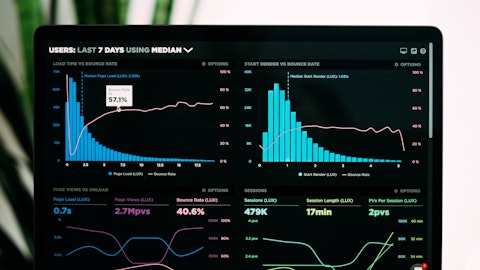Keith Jezek: Well, and again, this is Keith speaking. I love the nuance of your question, because what we are seeing is, in addition to being what we call in the industry lent out. So their loan to share ratios being at decades high and with share growth being at decades low, they had to in 2023, for the first time, take on these CECL reserves. So it was this, almost this triple whammy to slow down the potential growth in lending. Our value proposition, the discussions that we have around CECL are just as valid and just as valuable as ever before. And we’re engaged weekly in conversation with current customers and prospective customers about the value of the program to get them this much needed relief.
David Scharf: Got it. Thank you very much. Very helpful.
Keith Jezek: Thank you.
Operator: Thank you. Next question comes from the line of Kyle Peterson with Needham & Company. Please go ahead.
Kyle Peterson: Hey, great. Good afternoon, guys. Thanks for taking the questions. I wanted to start off on some of the profit share developments in the ASC 606 adjustments. Just wanted to kind of get a sense of how you guys are thinking about, at least in the 1Q guide, some of the different macro assumptions, just so we can kind of model in what the expected changes on the prior period developments are. Obviously, we’ve taken a couple negative revisions the last couple of quarters, but what are you guys assuming at least over the next couple of months here on that front?
Chuck Jehl: Yes. Hey, Kyle, it’s Chuck. I’ll start; maybe we just step back and just kind of think about the industry a bit. The credit market has worsened throughout fiscal 2023 for all participants in consumer savings eroded, credit card debt increased, delinquency rates increased and then loan loss across lenders continued to grow throughout the year. Delinquency for auto 15-year plus highs and despite Open Lending, if you think about our strength of our decision and pricing engine, we’re not immune to the overall performance of credit like a lender. But it’s important to note we’re not the lender and we’re dependent on defaults and — delinquencies and defaults lenders and their servicing. So we’re not a servicer. So I think that backdrop kind of points to delinquencies, 60-plus day delinquencies in our book or 100 basis points better than the 60 plus in the non-prime in the industry.
So we’re 4.5%, 60 plus and the industry is 5.5%. I think as we think about the $14.3 million and what we booked in the quarter and you think about the Manheim Used Vehicle Value Index, the MUVVI, what we’re seeing right now are the worst performing vintages. Call it late 2021, and into 2022, those vintages are put on the peak of the Manheim and the highs and that’s the peak claims and defaults 18 months to 24 months out. So that’s what we’re seeing in working through as a company and everybody in the industry is. So if you think about the $14.3 million we booked, it was merely just frequency of default was the main driver in the quarter and then also severity of loss. The Manheim Vehicle — the MUVVI came down more than the industry expected, more than Cox expected, and that impacted us as well.
So those were two negative impacts and then there was prepay speeds were better than we projected and that was a positive impact. So you put all that together, that’s what generated the back book adjustment of the $14.3 million in the book. So as we think about moving forward, your comment, we feel like 18 months to 24 months past those worst performing vintages, we feel like we’re well into and feel like hopefully that’s something that’s going to be behind us soon. So — but I hope that’s helpful. I just wanted to give a little bit of perspective on the kind of the back, in the measures that we’ve taken, Keith mentioned in the prepared comments, we’ve implemented a new scorecard LT 2.0 card that’s going to be a better predictor of default delinquencies than default and the appropriate price for the risk and take less risk on certain different scores and credits.
So we believe we’re taking the appropriate actions to continue to protect our book.
Kyle Peterson: That’s helpful. I appreciate the color. And just to follow-up a little bit, I know there’s been a lot of conversation with some of the different bank volatility and concerns about concentration, specifically in some commercial real estate assets and such. But how have some of your conversations gone, I guess particularly with the bank clients, given some of the regulatory impetus to diversify the loan book, has there been more appetite from some banks that might have historically skewed a little more commercial to maybe partner with you guys to diversify the loan book, or you guys not seen any impacts from some of the recent volatility with your New York community banks and such as of late?
Keith Jezek: Yes. And this is Keith speaking. I think it’s a good question. We were just at a large automotive finance conference last couple of weeks ago, and there’s a heightened interest from banks to grow the book of business around auto and then specifically to kind of grow this book of business around this near non-prime sector. As you well know, they need to check all types of fair lending boxes and chief among those is the CRA, the Community Relief Act. So there’s a great deal of interest in growing this book of business with the bank segment. That’s one of the reasons why, as I noted in our 2024 priorities, that we’re focusing more heavily on that cohort.
Kyle Peterson: Very helpful. Thanks, guys.
Keith Jezek: Thank you.
Chuck Jehl: Thank you.
Operator: Thank you. Next question comes from the line of John Hecht with Jefferies. Please go ahead.
John Hecht: Yes. Afternoon, guys. Thanks very much. First question is, how do we think about, I guess, seasonality of Certs this year? I mean, usually there is a seasonal element to the business, but at the same time, you’re talking about maybe Trans bottoming out and maybe as you go through the year, you might get some organic growth, kind of same-store sales type of activity with the newer counterparties that you guys have signed up. So, I mean, do you think that Certs, which you kind of in the middle of the range, you kind of sit flat in the first quarter from Q4. Is there a chance or an expectation that the Cert activity would grow throughout the year or will it follow more seasonal trends as we think about forecasting?



